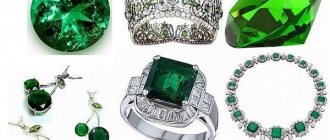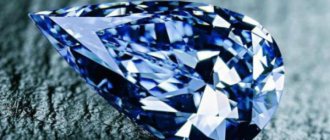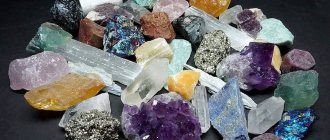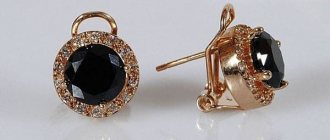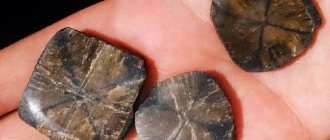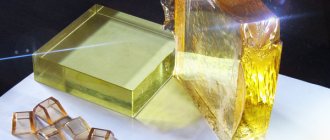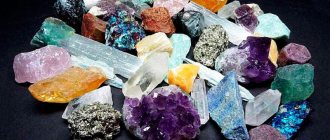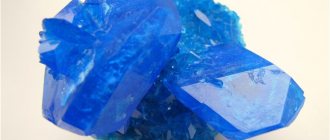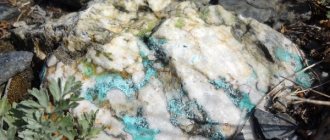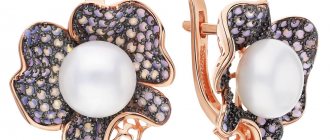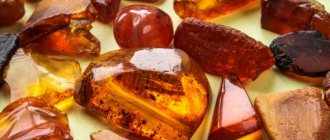| Category | Beryls |
| Title in English | Emerald |
| Formula | Be3Al2Si6O18 |
| Group | Beryl group |
| Color | Yellowish-green, Green |
| Stroke color | White |
| Shine | Glass |
| Transparency | Transparent, Translucent |
| singonia | Hexagonal |
| Hardness | 7,5 — 8 |
| Cleavage | Imperfect |
| Density, g/cm³ | 2,69 — 2,78 |
| Kink | Conchoidal, Uneven |
| origin of name | Emerald jewelry was sold back in Babylon, and this is the 3rd millennium BC. Although, historians say that evidence has been found that emerald mining was carried out back in the 19th century BC. The field was located near the Red Sea and was controlled by the Egyptians. Due to the fact that humanity has long been familiar with this precious stone, the history of the emergence of the term “emerald” is rooted in the deep past. The modern form of the Russian word emerald owes its appearance to the Turkish word zümrüt. It, in turn, comes from the Persian zumurrud. But the Persians have already borrowed their version from Greek. The Greeks used the term σμάραγδος or smaragdos - green stone. It is interesting that even the ancient Greeks did not completely own the word. They used a root from the Semitic language - brq. It is translated as “to shine.” The English version of the name for emerald, emerald, also appeared thanks to the Greek. But this word came to Europe from vulgar Latin (common) - Esmaraldus. In ancient French the term was written as Esmeraude. In Middle English it became Emeraude, modified over time and got the form we have now. By the way, the name Esmeralda is translated as a green gem or emerald. |
| Morphology | The natural formation of emeralds occurs due to the interaction of felsic magma with rocks that host ultramafic igneous rocks. Therefore, the natural place of formation of emeralds is represented by zones with high or medium-temperature leaching - greisenization. Rarely, there are cases of emerald formation due to exocontacts of pegmatites. But it is worth considering that then the stones come in small sizes. It is believed that the best quality emeralds come from hydrothermal veins located in carbonaceous shales. |
Emerald is a gemstone from the beryl group of the first order and is equal in value to diamond, sapphire, ruby, chrysoberyl, alexandrite, noble spinel and euclase. The quality of a mineral is determined by its color characteristics and degree of transparency. An ideal specimen should be absolutely transparent with a uniform, rich color. A large, flawless, brightly colored emerald weighing over 5 carats is valued even more expensive than a diamond.
Emerald deposits
High-quality emeralds are rare and are mined in countries such as Colombia, New Granada, Zambia, Brazil and Egypt.
Low quality samples are common in Austria, Ireland, and Norway. — Advertising —
In addition, Russia, USA, Canada, Australia, Spain, France, Switzerland, Italy, Germany, Bulgaria, Kazakhstan, Pakistan, Afghanistan, India, China, Cambodia, Ethiopia, South Africa, Somalia, Nigeria, Namibia, Tanzania are well known among emerald suppliers. , Zimbabwe, Mozambique and Madagascar.
History of emerald
The term “emerald” has Persian roots, which were transformed into the Latin smaragdus and were then used by many peoples of the world.
Even in ancient times, emeralds were highly valued. In Babylon they were an object of trade as early as 4000 BC. e. Ancient Egypt was famous for its emerald mines, which were discovered in the 19th century along with tools from 1300 BC. e. The rulers of India also valued emeralds. Sultan Shah Jahan, who built the magnificent Taj Mahal, the greatest symbol of love and fidelity, used emeralds as talismans. In addition, they were engraved with sacred texts.
And now, like many centuries ago, emeralds remain one of the most popular gems.
Gemstone deposits
The name of the gem has Persian roots. In different countries, the word “zumrundi” (green) was transformed into “maragd”, “smaragdos”, “esmerald”, “emerald”. The most ancient developments were carried out in the deserts of Arabia (Ancient Egypt) and Namibia (Cleopatra's mines). Ancient manuscripts mention emerald ore mined here. Much later, only in the second half of the 16th century, Colombian emerald entered the jewelry market. It currently accounts for more than half of global production. Even later, deposits were discovered in the Urals, India and South Africa.
The stones supplied by Columbia received the highest score from jewelers for color. They have a juicy grassy color, sometimes with a slight bluish tint. Deposits near the capital Bogotá produce gems of rare purity, while stones from most other Colombian mines are mostly opaque. However, even a relatively inexpensive, cloudy mineral has high color characteristics.
The main mining of Indian emeralds takes place in the state of Rajasthan in the north-west of the state. Most often they are a cool blue hue, sometimes so distinct that it reduces the value of the stone. In addition, the blue color, which is not very valued in emeralds, is due to a large number of impurities, which greatly reduces the brilliance and transparency of the gem. All this reduces the demand for Indian crystals, although they are more popular among Asians than among Americans and Europeans.
Emerald stone is not so often found in European countries such as Austria, Bulgaria, Germany, Italy, Norway, Ukraine, France. Some deposits have a small volume of mineral reserves, while others are of low quality minerals. They are also found in a number of African countries and even in Australia. Emerald ore is mined on an industrial scale in Brazil. The crystals obtained from it are much purer than Colombian gems. However, they are usually yellowish in color and significantly lighter in color. Only extremely rare stones have a true emerald color, which is most valued by both jewelers and buyers.
Gold earrings with emeralds and diamonds (go to the SUNLIGHT catalogue)
Record emerald
— Advertising —
The world's largest emerald, originally from Colombia, was named "Fura". Its weight was 11,000 carats and its price was $150 million. The second largest mineral, named “Tena,” weighs 2,000 carats. The record holder for cut stones called “Theodora” weighing 11.5 kg was valued at $1,500,000. Before treatment, his weight was 28 kg.
Emerald: last among the first
Frozen antiquity
Emerald is the last mineral among the highest class of gemstones (if you take into account the Mohs scale). In Sanskrit and Persian, the name of this stone sounded like “zammorod” and “zumundi”, which meant “green”, and in Old Slavonic emeralds were called “smaragd”.
But the English word emerald appeared only in the 16th century. There is a version that this is the name given to all minerals that are green in color.
Emphasizing the aristocratic nature of the stone, its “inaccessibility” and transparency, people nicknamed the gem green ice.
What did emerald do to deserve such a reputation?
Mysteries of history
Like many other gems, green minerals sometimes became the makers of history.
So, at the beginning of the 16th century, conquistador Fernando Cortes wanted to give his bride five rare emeralds. The minerals were distinguished not only by their unsurpassed quality, but also by their special shape in the form of a rose, bell, goblet, horn and fish. In order to get the stones, a desperate Mexican stole them from the Incas.
Cortes did not know that Queen Isabella of Castile, who became his mortal enemy, was hunting the stones with him. The story of the emeralds only added fuel to the fire of the then raging struggle between two clans for the Spanish throne. However, none of the jewel hunters were victorious.
In 1541, the unique stones mysteriously disappeared.
Igneous mineral
Emerald is of igneous origin and is a type of beryl. However, it is easy to distinguish from other stones of similar color due to its high degree of purity and transparency, as well as its cool shade of green.
Along with diamond and ruby, it is considered one of the most expensive minerals. According to the law “On Currency Regulation” in Russia, this stone is equated to freely convertible currency, that is, it can be exchanged for any foreign currencies, act as payments in international transactions, and also participate in trading on the main foreign exchange markets. Unlike many other beryls, emerald is quite soft. Therefore, if products with green minerals are stored incorrectly, the stones lose their original shine and become dull.
Colorless oil or oil tinted with green pigment will help to enhance natural emeralds and give them a special shine. This method is often used by jewelers from different countries.
Many years ago, the German physicist Goldschmidt, while studying the mineral, discovered that the color of an emerald depends on the amount of chromium or vanadium impurities.
The largest Theodore emerald, 57,700 carats (11.5 kg.)
Natural stones, as a rule, have many defects, so it is quite difficult to find gems in nature that are ideal in purity and shade. Thus, during mining, minerals weighing hundreds of carats are found, but have no jewelry value. At the same time, rare pure bluish-green emeralds can cost more than diamonds.
The most valuable emeralds are called “antique”. These stones have a rich dark green color, which samples mined from new deposits do not have.
In nature, there are many minerals similar to emeralds: green garnet, jade, tourmaline, tsavorite, fluorite and other stones of a similar shade. How not to confuse them?
You can distinguish emerald from other green gems using a refractometer. This special device measures the refraction of light that occurs in a particular stone. The emerald indicator is approximately 1.58 units.
Modern technologies
Most often, gem-quality emeralds are relatively small in size, but modern production often uses artificially grown or synthetic minerals. The main growing methods are flux and hydrothermal. To do this, the crystals are placed in an environment whose temperature is about 600 degrees Celsius, and the atmospheric pressure can reach up to 1400 atm.
Jewelers also use the ancient technology of making doublet stones, connecting two small emeralds or an emerald and some other mineral.
Emerald cut
Emerald is one of the few stones after which a certain method of cutting minerals, widely used in jewelry production, was named.
This is a type of step cut, in which the stone is given a rectangular shape with beveled corners. The emerald cut protects even the most fragile minerals from damage and chips, and also advantageously represents the color of the stone and its purity.
Southern stone
When valuing expensive stones, their location often plays an important role. So, for example, the best sapphires are considered to be those from Kashmir, the highest quality rubies are those from Burmese, but those from Colombia are recognized as the standard emeralds. It is in Colombia that the famous Muso mines are located, where amazing bright green minerals are mined.
The famous Etbay deposits of Jebel Zubara and Jebel Sikait are located in a mountain range on the Red Sea coast at an altitude of 550 m.
In addition, precious minerals are mined in Eastern and Southern Africa, Egypt, India and Pakistan. In Russia, the Urals are famous for their emerald deposits.
Experts can recognize the “nationality” of each stone by special inclusions characteristic of minerals of a certain country.
In addition to Colombian ones, gems from Zimbabwe are also especially valued, which are still cheaper than standard stones.
Star image
Having never lost its value, this precious mineral is still very relevant today. In the right frame, even classic products with emerald inserts sound new and modern.
Most often the stone has a gold frame. Supplemented with diamonds, jewelry with emeralds looks sophisticated and elegant. Such products will be a wonderful accent to your evening look.
Emerald jewelry may well become a family heirloom. Luxurious gems are preferred by style icons such as Sherlize Theron. Sharon Stone, Beyoncé, Cameron Diaz, Dita Von Teese and others.
Physico-chemical characteristics of emerald
Emerald is a type of beryl, a colorless stone that is colored by impurities of certain metals.
Thus, emeralds are characterized by a rich velvety green color, with a blue tint due to the presence of chromium, iron and vanadium in the mineral composition. Emerald crystals have an elongated prismatic shape. They are transparent or translucent, fragile with a glassy sheen, without cleavage, uneven or conchoidal at the edges.
The hardness of emerald on the Mohs scale is 7.5-8.0. The specific gravity is 2.8 g/cm3. Refraction from 1.576 to 1.582.
Historical and largest emeralds
Alpine mines are considered one of the most ancient in Europe. It is believed that the crown of Saint Louis is crowned with poorly processed bluestone, quarried in the Austrian Habachtal valley. But a transparent green specimen found there, through which the Roman emperor loved to watch gladiatorial fights, was called Nero’s emerald by mistake, since it actually turned out to be chrysolite. Certain varieties of these minerals, especially without the correct cut, are very similar, which is why this misconception arose.
The Devonshire Emerald, given by the former King of Brazil to the Duke of Devonshire, is world famous. Its weight was approximately 1384 carats. The flat “Mughal” weighing 217.8 carats is famous for the fact that one of its sides is decorated with a floral design, and on the other there is an engraving of the texts of Muslim prayers. There are protrusions along the edges so that the crystal can be secured to the turban.
A Buddha figurine was carved from a 3,600-carat gem mined in Madagascar at the end of the 20th century. And at one time a vessel for ointment was made from a dark emerald weighing 2680 carats. It is now in the Vienna Museum.
Experts have still not come to a consensus on whether the huge beryl from Brazil “Teodora” weighing 11.5 kg, and with dimensions comparable to a watermelon, has the right to be called an emerald. The description of the stone indicates that about a quarter of it is not colored, and only the top layer of 3-5 cm is bright green. So for now, the championship among cut emeralds is held by another Brazilian gem, weighing 7.5 kg (37,500 carats). Other large minerals of the highest quality were also given proper names: crystal from Gachara (7025 carats), Austrian emerald (2681 carats), Patricia (632 carats).
Magical properties of emerald
The main task of the emerald is to overcome the bad inclinations of its owner: deceit, a tendency to cheat, and infidelity to loved ones.
If the owner of the stone does not have such inclinations, then the emerald will bring him good health and success. And if the gem doesn’t like a person’s behavior, he can even punish him. Emerald reacts especially poorly to aggression and rudeness. Emeralds dispel negative energy, cleanse a person’s aura and his home from everything negative. They are considered the patrons of the family hearth: they maintain peace and harmony between spouses, and have a positive influence on procreation.
Psychics use emeralds to contact the souls of the dead and understand signals from higher powers.
The healing properties of emerald
Emeralds can stabilize blood pressure, relieve pain in the head and joints, and help in the treatment of diseases of the gastrointestinal tract and bladder inflammation.
They are characterized by a pronounced antibacterial effect. Previously, the stone was used to treat night blindness, cataract, and epilepsy. Modern lithotherapy suggests using the gem to eliminate nightmares, insomnia, groundless fears and increased fatigue.
Industries where emerald is used
The main use of emeralds is their use in jewelry.
Rich dark green samples are considered the most valuable; even if they contain foreign inclusions, they are valued more than pale stones. Emerald inserts decorate jewelry and are kept in museums and private collections. In addition, natural emeralds are used in the manufacture of solid-state lasers, and synthetic stones are used in quantum electronics.
The meaning of emerald in religion and culture of mankind
Emeralds were highly valued even in the times of Pliny and Theophrastus, and, according to Herodotus, the ring of Polycrates featured an amazing emerald. Both the ancient Greeks and the ancient Egyptians valued emeralds very much (they used the stones as decorations for mummies).
After all, according to the ancient Egyptian Book of the Dead, the emerald was a gift from the god Thoth. The green color of the stone symbolizes the arrival of spring and the rebirth of the body after death. Smaragd was called in Egypt the stone of the goddess Isis; it was credited with the ability to turn dreams into reality, predict the future, see the past and read minds. There was a belief that emerald endowed a person with unchanging love and fidelity. Therefore, this gift was honored by future mothers and all hearth keepers.
In the old days, it was also believed that emerald was a powerful talisman that restored vision and helped avoid poisonous snake bites (probably due to its “aggressive” green hue). As one legend says, Emperor Nero himself owned an emerald, which he used as a monocle during gladiator fights.
It is noteworthy that in Islamic culture the green emerald has always been considered a desirable magical stone, and in the Christian tradition, on the contrary, a witchcraft stone, a product of hellfire.
Artificial emerald
Since the 19th century, scientists from many countries have been involved in the task of creating artificial emeralds.
For the first time this was possible only in 1935 in Germany, when G. Espig and his colleagues obtained the so-called “igmerald”. 5 years later, industrial production of the synthetic mineral was established in the USA. Today, artificial emeralds are produced in countries such as Germany, France, Switzerland, Japan, Russia and Belarus. The world's largest (a joint enterprise between Russia and Thailand) synthesizes emeralds that are identical in chemical composition to natural Colombian ones. Synthetic emeralds often reach large sizes up to hundreds of carats, but the technology for their production remains a secret of the enterprises and is not disclosed.
In general, modern synthetic emeralds are no different in appearance from natural ones, and the quality is even higher. Moreover, their price is much lower than natural stones, which are quite rare.
What was the name for emerald in Russia in the old days?
Smaragd, being a rare and valuable stone, was very loved in Rus'. However, they received it only from overseas regions, or rather from India, where at that time it was in abundance. If you believe written sources, emerald was used at that time even in the manufacture of glasses, which, of course, are inferior in quality to today's glass glasses.
But at that time, only wealthy and influential people could afford to wear glasses. Also, emerald (as it was called in the old days, emerald) was a desirable adornment for every beauty of those times, and even now many enjoy wearing it as a fashion accessory.
How to distinguish an artificial emerald from a natural one
Artificial emerald is very similar to natural stone, but its specific gravity and refractive index are lower. In addition, it is characterized by a bluish-green tint. In the Chelsea filter it looks bright red. It is also possible to distinguish between natural and synthetic emeralds using ultraviolet radiation (wavelength 360 nm), a real stone does not react to it, but a synthetic one luminesces in a chestnut-brown color. But this pattern may not be observed.
Emerald and zodiac sign
Emeralds are recommended for nervous people with increased sensitivity; it helps them avoid stress and exposes scammers and deceivers.
The gem is well suited for Leo, Libra and Aquarius. Emerald is absolutely not recommended for Pisces, Capricorns and Scorpios. Representatives of other zodiac signs can wear jewelry with it without any worries.
Prices for emerald products
Low-quality emerald prices start at $350 per carat, while high-quality stones start at $8,500 per carat, which is influenced by the color, clarity and origin of the stone. As the weight of a gem increases, its value also increases. Thus, specimens with rich color and weight of 5 carats are valued at $15,000 per carat.
The name of emerald in the old days
The Latin language became the ancestor of many languages; it laid down the basic church concepts and enriched many languages with scientific and philosophical terms.
Once upon a time, this language was a universal means of communication among priests, scholars and nobles. Knowledge of this language was considered the highest merit among the intelligentsia, as it opened many roads to the inquisitive mind of the person who speaks it. What was the name for emerald in the old days? The Latin word for emerald, smaragdus, can literally be translated as "green." The fact is that a language so complex in the construction of speech patterns was built on simple concepts: an object or quality was often assessed and named by its properties and color. From here it is easy to guess that the Russian language, absorbing all new items and meanings with incredible speed, has adopted the overseas word. Therefore, it is not difficult to guess what emerald was called in ancient times in Rus'. This stone was called Smaragd, almost completely borrowing the word “from beyond the hill.”
